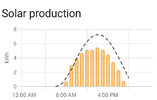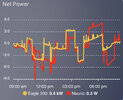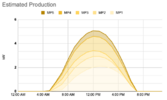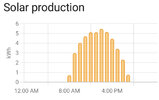Hello,
My tesla solar system (no powerwall) was recently installed. Its a 7.6kW system with the 7.6kW tesla inverter. They also installed the Neurio device with 3 CTs - two on the 2 live wires going to the meter and one on one of inverter outputs. I also have a Eagle-200 device that connects to the meter wirelessly and tracks the net demand. I am using home-assistant and the forecast integration to estimate the production. It lets you enter the azimuth and pitch of each panel array and also considers the weather condition to make the estimate - a lot of people in forums report it to be pretty accurate. But I observed the following in the last few days-
1. My production is lower than the estimate home-assistant is making. A picture of the forecast and actual production is attached.
2. Neurio and eagle-200 numbers are different. Neurio numbers are lower most of the time.
I am located in San Jose, CA. I am wondering is this behavior expected? How accurate the Neurio numbers are in general?
Thank you.
My tesla solar system (no powerwall) was recently installed. Its a 7.6kW system with the 7.6kW tesla inverter. They also installed the Neurio device with 3 CTs - two on the 2 live wires going to the meter and one on one of inverter outputs. I also have a Eagle-200 device that connects to the meter wirelessly and tracks the net demand. I am using home-assistant and the forecast integration to estimate the production. It lets you enter the azimuth and pitch of each panel array and also considers the weather condition to make the estimate - a lot of people in forums report it to be pretty accurate. But I observed the following in the last few days-
1. My production is lower than the estimate home-assistant is making. A picture of the forecast and actual production is attached.
2. Neurio and eagle-200 numbers are different. Neurio numbers are lower most of the time.
I am located in San Jose, CA. I am wondering is this behavior expected? How accurate the Neurio numbers are in general?
Thank you.






